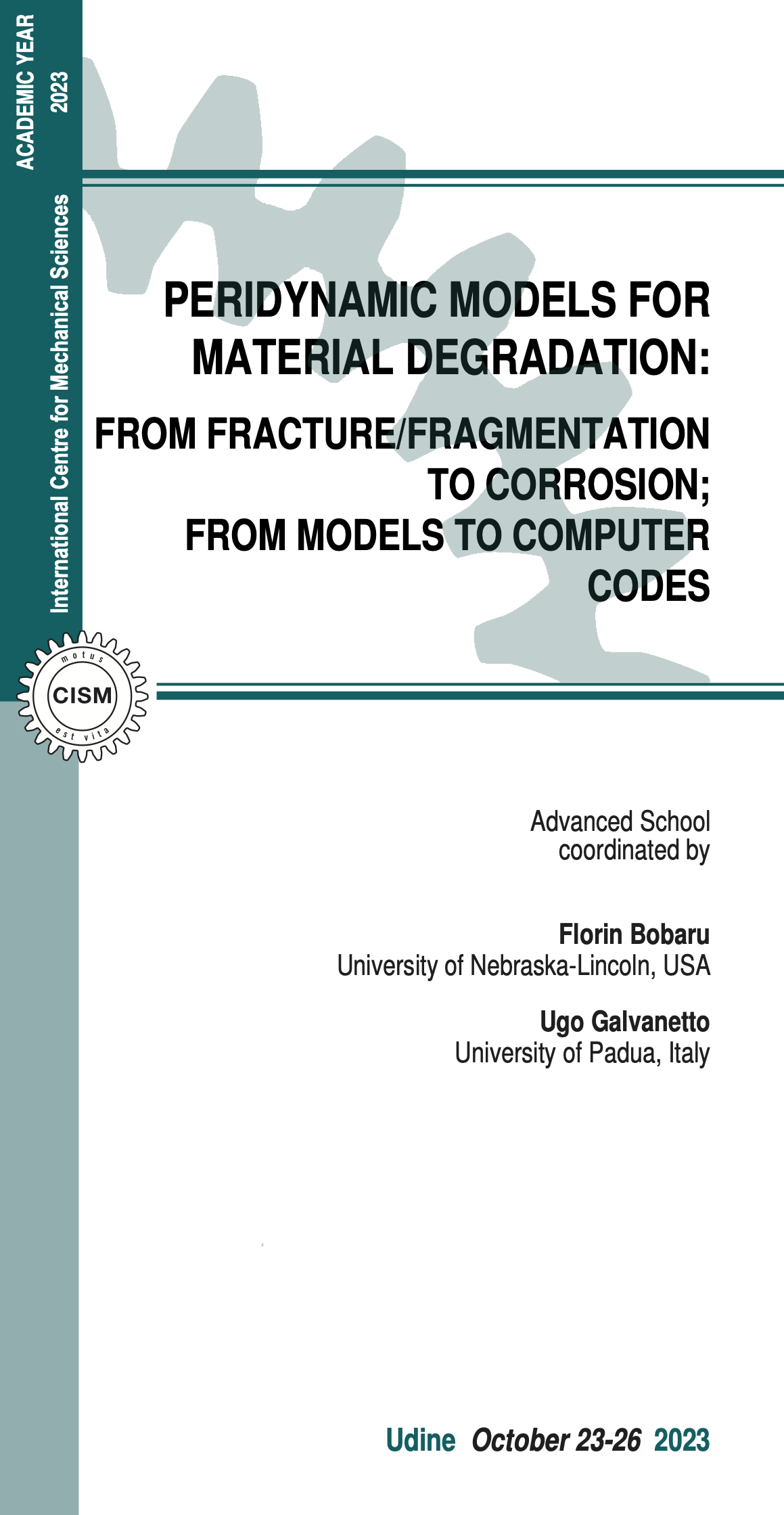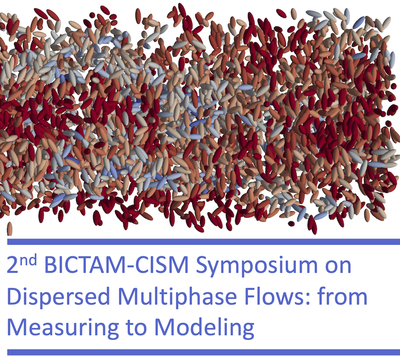Peridynamic (PD) models are ideally suited for simulating damage (fracture, fragmentation, dissolution, corrosion, erosion, etc.) because nonlocality allows various failure mechanisms to be represented, in an average sense, seamlessly across multiple scales, while maintaining the dominant length-scale in the description. This course presents PD formulations of general material failure/degradation phenomena, including: dynamic brittle fracture, shear banding and ductile failure, corrosion damage, damage in concrete structures, thermomechanical failure, fracture in composite and porous materials, etc.
FFurthermore, strategies to couple classical continuum mechanics and PD will be discussed and applied to the coupling of FEM meshes and PD grids. A special emphasis will be placed on transitioning from a mathematical formulation to numerical solutions.
Participants will gain hands-on experience with open-source Matlab codes implementing FEM-PD coupled models to simulate crack propagation problems, and fast pseudo-spectral solvers for PD models of dynamic fracture and corrosion. Differences from other nonlocal models, and confusing terms used in the published literature will be clarified. Other advanced topis will be addressed. The course is aimed at researchers and graduate students in the fields of mechanical, aerospace, civil and biomedical engineering, applied mathematics, electrochemical engineering, physics, and biophysics.
Dr. Bobaru will introduce the peridynamic formulation as a general continuum/discontinuum theory of mechanics and thermodynamics. PD formulations do not use spatial derivatives, allowing them to handle material failure (fracture, damage, dissolution, etc.) in a mathematically consistent way. He will present two types of numerical methods that are particularly well suited for discretizing PD models: meshfree and pseudo-spectral methods. He will conduct hands-on sessions using Matlab-based implementations of pseudo-spectral methods for solving problems in fracture mechanics and corrosion damage. Dr. Bobaru will also show that analytical solutions for some PD problems in elasticity and heat/mass transfer are no more difficult to find than for classical PDE-based problems.
Dr. Galvanetto will discuss how PD can be used in conjunction with classical methods to study multiphysics problems. He will address problems specific to PD, such as the imposition of the boundary conditions, or to its numerical implementation, such as the accurate computation of the integrals or solution sensitivity to grid orientation.
Dr. Zaccariotto will discuss a strategy to couple classical continuum mechanics and PD. The method will not only be described theoretically but also through practical sessions using Matlab-based codes. Moreover, the often-neglected issue of verifying overall structural equilibrium in coupled FEM-PD models will be discussed. Finally, he will provide an accurate description of an implicit static solution procedure.
Dr. Diana will introduce a unified theoretical and computational scheme for pair-potentials based continuum-molecular modelling of anisotropic elasticity, fracture and diffusion-type problems within the framework of a revised bond-based peridynamic theory with oriented material points. Finally he will propose a general micro-macro moduli correspondence procedure.
F Bobaru, JT Foster, PH Geubelle, SA Silling, Handbook of peridynamic modeling, CRC press, 2016.
S Jafarzadeh, F Mousavi, A Larios, F Bobaru, “A general and fast convolution-based method for peridynamics: Applications to elasticity and brittle fracture”, Computer Methods in Applied Mechanics and Engineering 392, 114666, 2022.
Z Chen, S Jafarzadeh, J Zhao, F Bobaru, “A coupled mechano-chemical peridynamic model for pit-to-crack transition in stress-corrosion cracking”, Journal of the Mechanics and Physics of Solids 146, 104203, 2021.
T Ni, M Zaccariotto, Q-Z Zhu, U Galvanetto, Static solution of crack propagation problems in Peridynamics, Computer Methods in Applied Mechanics and Eng-ineering 346, pp. 126-151, 2019.
M Zaccariotto, T Mudric, D Tomasi, A Shojaei, U Galvanetto, Coupling of FEM meshes with Peridynamic grids, Computer Methods in Applied Mechanics and Engineering 330, pp. 471-497, 2018.
V. Diana, Anisotropic continuum-molecular models: A unified framework based on pair potentials for elasticity, fracture and diffusion-type problems, Archives of Computational Methods in Engineering 30 (2023) 1305–1344.
15 lectures on: Peridynamic modeling and computations of damage and fracture
Introduction to Peridynamics for elasticity and brittle fracture; Constructing PD formulations for heat and mass transport; Analytical solutions to PD models; The meshfree method and pseudo-spectral fast solvers; Types of convergence for nonlocal models and comparisons between PD and Phase-field models; Hands-on demonstration of coding a fast-solver for PD models in dynamic brittle fracture and corrosion; The PD surface effect and its usefulness; Dynamic brittle fracture and impact damage; Thermomechanical fracture; Failure in composites and functionally graded materials; The IHPD model: fracture in concrete structures and in composites; Shear banding and ductile failure; Pitting and crevice corrosion damage; Electro-potential problems and galvanic corrosion; Dissolution of medicine, nonlocal Navier-Stokes equations and fluid flow.
5 lectures on: Anisotropic models for elasticity, fracture and diffusion- type problems
Peridynamic continua with oriented material points; Micro-macro moduli correspondence principle for anisotropic materials; Anisotropic fracture models and anisotropic diffusion-type formulations; Constitutive models for micropolar elasticity; Numerical experiments: fracture in cortical bone, length-scale sensitivity and chiral effects in architected materials.
Using PD and FEM to solve Multiphysics problems; The problem of Boundary conditions and how to impose them in PD in a ‘local manner’; Accurate numerical quadrature in the ‘classical’ mesh-less numerical implementation; Sensitivity of cracked solutions on the grid orientation; PD approaches to describe fatigue crack propagation in structural materials.
5 lectures on: Coupling of Peridynamics and Classical continuum mechanics: pros & cons
Strategies of coupling Peridynamics and Classical continuum mechanics (CCM): the coupling of FEM meshes and PD grids; Coupling of CCM and PD in a meshless way and study of Multi-grid PD models; Issues in the coupling approach: the out-off balance error and strategies to reduce it; Practical sessions using open-source Matlab-based codes of FEM-PD coupled models; Implicit static solution procedure for PD models.
The course is offered in a hybrid format giving the possibility to attend the course also by remote (on Microsoft Teams platform).
On-site places are limited and assigned on first come first served basis.
The registration fees are:
- On-site participation, 400.00 Euro + VAT*
This fee includes a complimentary bag, five fixed menu buffet lunches, hot beverages, downloadable lecture notes.
Deadline for on-site application is September 23, 2023 October 8, 2023
- Online participation, 150.00 Euro + VAT*
This fee includes downloadable lecture notes.
Deadline for online application is October 4, 2023 October 8, 2023.
Application forms should be sent on-line through the following web site: http://www.cism.it
A message of confirmation will be sent to accepted participants.
Upon request a limited number of on-site participants can be accommodated at CISM Guest House at the price of 35 Euro per person/night (mail to: foresteria@cism.it).
CANCELLATION POLICY
Applicants may cancel their registration and receive a full refund by notifying CISM Secretariat in writing (by email) no later than:
- September 23, 2023 for on-site participants (no refund after the deadline);
- October 4, 2023 for online participants (no refund after the deadline).
Incorrect payments are subject to Euro 50,00 handling fee.
where applicable (bank charges are not included). Italian VAT is 22%.

